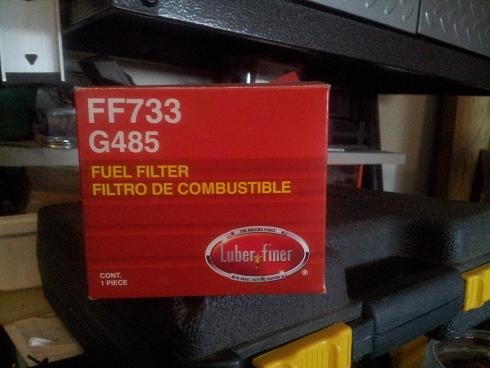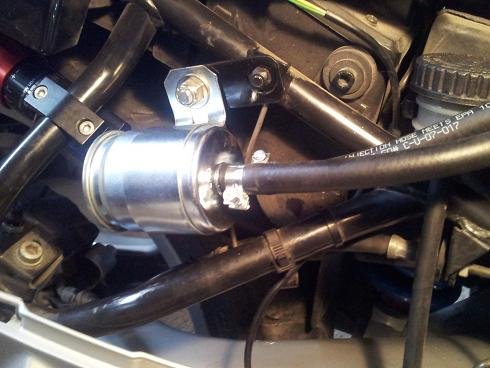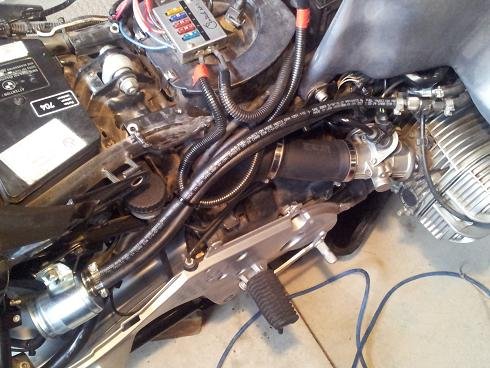I am attempting to relocate the fuel filter on my 2000 R1100 RT. I read an article in the ibmwr tech pages by Rob Lentini concerning this modification. He did this procedure on an R model and this is where the problem arises. He relocated the filter to an area under the throttle body air intake and secured it using an Adel clamp attached to the brake line support, On the RT there isn't enough space in this area for a filter the size he recommends which is similar to the BMW oe filter. There is interference with the fairing mounting tab on the footrest bracket and it doesn't appear that the filter would clear the fairing when installed. I think I can mount the filter upstream under the tank by attaching the Adel clamp to the screw that attaches the fuel line and fuel pump wiring harness bracket to the bottom of the tank. In this position the filter sits about 1/2 inch above the cylinder. Is this too close to the cylinder due to heat? It also looks like there is room near the fuel pump plate between the fuel tank and the frame. Has anyone done this switch on an RT? Any advice would be helpful. I made an error saying this mod was done on an R model. It was an RS.
Navigation
Install the app
How to install the app on iOS
Follow along with the video below to see how to install our site as a web app on your home screen.
Note: This feature may not be available in some browsers.
More options
-

Welcome! You are currently logged out of the forum. Some forum content will be hidden from you if you remain logged out. If you want to view all content, please LOG IN!If you are not an MOA member, why not take the time to join the club, so you can enjoy posting on the forum, the BMW Owners News magazine, and all of the benefits of membership? If you click here, you have the opportunity to take us for a test ride at our expense. Enter the code 'FORUM25' in the activation code box to try the first year of the MOA on us!
You are using an out of date browser. It may not display this or other websites correctly.
You should upgrade or use an alternative browser.
You should upgrade or use an alternative browser.
2000 R1100RT fuel filter relocation
- Thread starter littledog
- Start date
More options
Who Replied?snookers
DBLUPPR
I did the external fuel filter mod on my 1100RT a few years ago, for if no other reason, easy access.
I used an automobole filter fuel filter ....the number is on the box in the picture below.

I use this style filter because it comes equiped with a mounting bracket as part of the filter body. It is mounted behind the right side black plastic panel of the bike. Remove the sidecase and cover panel and there you have it.....easy peasey.


It should be noted that if you do this mod, you should remove the OEM fuel filter from the tank and insert a peice of tubing in its place.....I believe I used 5/16 steel brake line and gentley flared both ends to the tubing would not back out of the rubber fuel lines.
You may also wish to install Quick Disconnects on the fuel lines at this time as well.
I used an automobole filter fuel filter ....the number is on the box in the picture below.

I use this style filter because it comes equiped with a mounting bracket as part of the filter body. It is mounted behind the right side black plastic panel of the bike. Remove the sidecase and cover panel and there you have it.....easy peasey.


It should be noted that if you do this mod, you should remove the OEM fuel filter from the tank and insert a peice of tubing in its place.....I believe I used 5/16 steel brake line and gentley flared both ends to the tubing would not back out of the rubber fuel lines.
You may also wish to install Quick Disconnects on the fuel lines at this time as well.
Tank question
Guys, thanks for revisiting this. I am going to do this mod while the bike is down / apart. I am going to go into the tank and replace all the hoses, but have not opened it yet.
Instead of fabricating / installing a steel tube where the filter was, is there a way with longer length, proper type hose to make it 1 run from point to point from Pump outlet to fitting without the flared tubing to take the place of the filter?
Dadrider
Guys, thanks for revisiting this. I am going to do this mod while the bike is down / apart. I am going to go into the tank and replace all the hoses, but have not opened it yet.
Instead of fabricating / installing a steel tube where the filter was, is there a way with longer length, proper type hose to make it 1 run from point to point from Pump outlet to fitting without the flared tubing to take the place of the filter?
Dadrider
pauls1150
MOA #24991, south of Los Angeles
YES! Beemer Boneyard sells a pliable hard plastic line specifically for the "U" inside.
see - http://www.beemerboneyard.com/subhosekit.html
see - http://www.beemerboneyard.com/subhosekit.html
PGlaves
#13338
Thanks for all the info. I have another question that arises out of this conversation. When I eliminated the filter from inside the fuel tank I used a 12 inch piece of 5/8 fuel injection rated fuel line. Is this line OK inside the gas tank?
Probably not. It should be hose specifically for use submerged in fuel.
Somebody will (I hope) chime in with numbers and such.
snookers
DBLUPPR
In tank replacement line
Read up on this following info from " EURO MOTO ELECTRICS "
This is the line I installed in my bikes fuel tank
http://www.euromotoelectrics.com/BMW-Hose-for-In-Tank-Submersion-16-13-1-455-350-p/fp-hosekit.htm
Read up on this following info from " EURO MOTO ELECTRICS "
This is the line I installed in my bikes fuel tank
Part #: FP-HoseKit
Flexible Fuel Hose Kit
Vehicle Manufacturer: BMW
Application: 5/1985-1995 BMW K + Many other applications.
Make/Model: BMW , Ducati, Aprilia, Moto Guzzi
Model Years: ALL
Manufacturer #: replaces BMW Part No. 16 13 1 455 350
Rating: Meets SAE 30R10 specifications for submersible fuel line and pressure rated to 220 psi.
(refer to "Extended Information" Tab for more specific application information )
Note: Included in the FP-576KIT+. as well as FP-231KitPlus
Brand :
Features
Submersible Fuel Line Hose Kit -
includes flexible nylon hose x 2 .
Hose Length 5/16" (7mm - 8mm) ID x 10.5 inch ( 65 cm)
and x 4 hose clamps.
Designed for constant contact with fuel on the inside and the outside.
Meets SAE 30R10 specifications for submersible fuel line making it the perfect replacement for many fully immersed applications.
Design allows bending into a U-shape without kinking - can be used in R850/1100/1150, K75/100/1100/1200/1300 bikes and also R1200 series.
Replaces old deteriorated rubber hoses
Higher burst strength for greater reliability and longevity
Corrugate construction for increased articulation
This submersible fuel hose needs to be cut to length for the specific model it is being installed in. Most BMW applications, it is recommended to cut 1.5 inches ( 35mm ) off each end. Prior to fitment, run the both ends of the hoses over the fuel barb once to pre-expand the hose end for easier installation. Recommend taking the fuel pump out of the tank and pre-assemble everything then re-install back into fuel tank.
Read about a customers experience installing our submersible fuel hoses on a R1150.
http://www.euromotoelectrics.com/BMW-Hose-for-In-Tank-Submersion-16-13-1-455-350-p/fp-hosekit.htm
gsaddict
Pepperfool
Thanks for all the info. I have another question that arises out of this conversation. When I eliminated the filter from inside the fuel tank I used a 12 inch piece of 5/8 fuel injection rated fuel line. Is this line OK inside the gas tank?
Please read my post on this subject.
http://forums.bmwmoa.org/showthread.php?80618-Proof-that-SAE-30R9-fuel-line-cannot-be-submersed
roger 04 rt
New member
FWIW, I still don't understand the benefits of relocating the filter outside the tank. And the thought of fuel flowing in the filter above the air box is worrisome, another point of failure.
The BMW manual only calls for it to be replaced every 25,000 miles. Further, if the return-volume of fuel going back to the tank is measured, the filter might not need replacement for twice that interval.
For the cost of a 2' of injection hose and female QD, the return volume can be tested periodically or when filter contamination is expected.
The BMW manual only calls for it to be replaced every 25,000 miles. Further, if the return-volume of fuel going back to the tank is measured, the filter might not need replacement for twice that interval.
For the cost of a 2' of injection hose and female QD, the return volume can be tested periodically or when filter contamination is expected.
gsaddict
Pepperfool
FWIW, I still don't understand the benefits of relocating the filter outside the tank. And the thought of fuel flowing in the filter above the air box is worrisome, another point of failure.
The BMW manual only calls for it to be replaced every 25,000 miles. Further, if the return-volume of fuel going back to the tank is measured, the filter might not need replacement for twice that interval.
For the cost of a 2' of injection hose and female QD, the return volume can be tested periodically or when filter contamination is expected.
+1

PGlaves
#13338
FWIW, I still don't understand the benefits of relocating the filter outside the tank. And the thought of fuel flowing in the filter above the air box is worrisome, another point of failure.
The BMW manual only calls for it to be replaced every 25,000 miles. Further, if the return-volume of fuel going back to the tank is measured, the filter might not need replacement for twice that interval.
For the cost of a 2' of injection hose and female QD, the return volume can be tested periodically or when filter contamination is expected.
The issue is primarily one of rapid clogging or collapse of the filter media from a dose of sludge or more likely water in fuel. This can happen and has happened with even a nearly new filter installed. When it happens a rider does not need test equipment to know something is wrong.
Take an R1100RS for example. If a dose of crud from refueling clogs the filter along the highway 5 miles from the station, then:
1. Empty the tank
2. Remove the tank.
3. Lay the tank on its side on something. Remember this is a painted, finished, tank.
4. Remove the fuel pump plate.
5. Take what seems like 6 inches of stuff out a 5 inch hole. Don't disturb the vent line or drain line inside the tank, or they will leak.
6. Remove old filter.
7. Install new filter.
8. Try to get the swolen O ring to reseal the pump plate.
9. Maybe - maybe not now call roadside assistance because it won't seal up.
I have not had to do this beside the road but I have had the pleasure of doing it for a rally-goer on a picnic table at a rally.
Or, in the alternative, loosen two hose clamps, remove the external filter, install new filter, tighten two hose clamps.
The external filter with two hose clamps poses less risk than the two clamps holding each of two quick disconnects with a history of failure with the OEM plastic ones, and a history of O ring failure on any of them. And less risk than the spewing cracks in fuel pumps on more recent models. I actually have a high degree of confidence in two properly selected and installed hose clamps.
PGlaves
#13338
Yet to see that Paul.
Maybe we have better fuel up here.
Without a doubt.
Water in fuel is a distinct problem at many stations.
Up there the ice blocks are too big to get through the hose.
gsaddict
Pepperfool
Without a doubt.
Water in fuel is a distinct problem at many stations.
Up there the ice blocks are too big to get through the hose.

OOOH that hurts

FYI we have had a scorcher summer here, sorry to hear you are not attending Nakusp.

